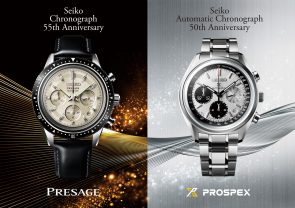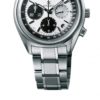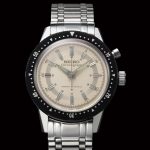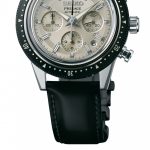The history of Seiko chronographs begins with a pocket chronograph created in the early 1940s. In 1969, the launch of Calibre 6139, the world's first automatic chronograph with a column wheel and vertical engagement, marked Seiko's contribution to the development of chronographs. Today, this long and proud tradition in time measurement is being celebrated thanks to two new automatic chronographs honouring as many historic models from 1964 and 1969 respectively, and belonging to the Presage and Prospex collections. Both will be available from December 2019 in Seiko Boutiques and at selected retailers worldwide. The first model is to celebrate the Corona Chronograph, launched by Seiko in 1964 at the Tokyo Olympic Games, and which was Seiko's first chronograph watch, and the first in Japan. Every part of the watch was designed from scratch and marked the beginning of Seiko's production of wrist chronographs. It had a simple 'single push-button' mechanism, but it amply displayed the same dedication to precision that would be fully expressed with Calibre 6139 and the movements that would be introduced in the following years, with a column wheel for sorting the chronograph functions. The new chronograph faithfully reflects the design of the 1964 Corona Chronograph with its box-shaped crystal, clearly defined numerical indices on the slim bezel, and a case with an inward sloping shape that allows the watch to fit snugly on the wrist. Every detail has been improved; the watch is fitted with Calibre 8R48 with a 45-hour power reserve indicator at 12 o'clock, the sapphire crystal has been treated with an anti-reflective coating on the inner surface and the lugs are polished using the Zaratsu technique. The watch is part of the Presage collection and is a limited edition of 1,000 pieces. The second model celebrated by Seiko is the 1969 chronograph, which celebrates 50 years since its launch this year. The launch of Calibre 6139 in 1969 was undoubtedly an important milestone in Seiko's history because it was one of the world's first automatic chronographs, but its real value lies in the fact that it included both the column wheel and the vertical coupling, devices that allowed Calibre 6139 to guarantee a real improvement in the precision with which time can be measured by a watch. Today, the combination of vertical coupling and column wheel, which in 1969 marked a major breakthrough in automatic wristwatches, is widely regarded as a prerequisite in a high-performance chronograph. The new limited edition Prospex watch that pays tribute to the 1969 model mounts Seiko's most advanced chronograph calibre, named 8R48, which was introduced in 2014. In addition to the vertical coupling and column wheel, it incorporates Seiko's exclusive three-pronged hammer and a heart-shaped cam, which ensure the perfect synchronisation of the 'flyback' hands. The watch was inspired by a popular model at the time, known among Seiko fans as the 'Panda' because of its black counters contrasting with the white dial. The current timepiece pays homage to the original by faithfully reproducing its brushed finish on the dial, the same hands and orange tip on the chronograph hand, the same hour markers and the same indications on the tachymeter bezel. In addition, the new timepiece features a third counter for the seconds hand for the current time, a Zaratsu polished case design and a box-shaped sapphire crystal. It belongs to the Prospex collection in a limited edition of 1,000 pieces.








